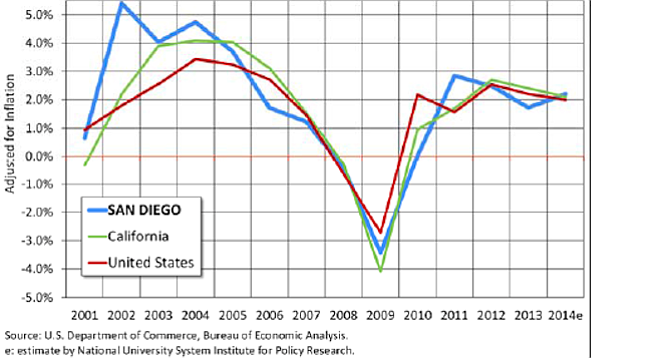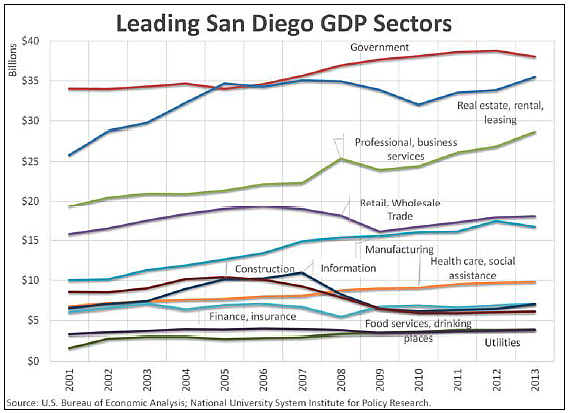 Facebook
Facebook
 X
X
 Instagram
Instagram
 TikTok
TikTok
 Youtube
Youtube

The total output of goods and services for the county hit $197.9 billion last year, according to economist Kelly Cunningham of the National University System Institute for Policy Research; that number is expected to rise to over $200 billion this year easily. Adjusted for inflation, the local economy will grow 2.2 percent this year, topping the state's 2.1 percent and the nation's 2.0 percent, forecasts Cunningham.
Cunningham's estimates are based on methodology revisions by the United States Bureau of Economic Analysis. Now, research and development expenditures, entertainment, literary, and other artistic property are considered capital. These changes, and others, would have boosted the estimates of San Diego's regional gross domestic product calculations between 2001 and 2012 by 5 to 7 percent.

San Diego's 1.7 percent inflation-adjusted growth last year equaled the average of 381 metropolitan areas. San Diego output recovered and moved ahead of Great Recession levels, but metro areas such as Atlanta and Phoenix have not yet moved back, and Miami, Detroit, Riverside-San Bernardino, and Las Vegas are still far below Great Recession levels. Cunningham calls San Diego's recovery "Goldilocks — neither hot nor cold."
Government and manufacturing continued to expand through the Great Recession, right up to 2013, when they faltered. Reason: the military buildup in those years and the government cutbacks and sequestration that began in 2013. Government activity is 20.6 percent of San Diego's economy.
In the San Diego metro area, information, construction, food services, accommodations, and retail trade have still not recovered from the Great Recession; professional and business services, real estate and leasing, and healthcare sectors, however, have more than recovered.


The total output of goods and services for the county hit $197.9 billion last year, according to economist Kelly Cunningham of the National University System Institute for Policy Research; that number is expected to rise to over $200 billion this year easily. Adjusted for inflation, the local economy will grow 2.2 percent this year, topping the state's 2.1 percent and the nation's 2.0 percent, forecasts Cunningham.
Cunningham's estimates are based on methodology revisions by the United States Bureau of Economic Analysis. Now, research and development expenditures, entertainment, literary, and other artistic property are considered capital. These changes, and others, would have boosted the estimates of San Diego's regional gross domestic product calculations between 2001 and 2012 by 5 to 7 percent.

San Diego's 1.7 percent inflation-adjusted growth last year equaled the average of 381 metropolitan areas. San Diego output recovered and moved ahead of Great Recession levels, but metro areas such as Atlanta and Phoenix have not yet moved back, and Miami, Detroit, Riverside-San Bernardino, and Las Vegas are still far below Great Recession levels. Cunningham calls San Diego's recovery "Goldilocks — neither hot nor cold."
Government and manufacturing continued to expand through the Great Recession, right up to 2013, when they faltered. Reason: the military buildup in those years and the government cutbacks and sequestration that began in 2013. Government activity is 20.6 percent of San Diego's economy.
In the San Diego metro area, information, construction, food services, accommodations, and retail trade have still not recovered from the Great Recession; professional and business services, real estate and leasing, and healthcare sectors, however, have more than recovered.
Comments